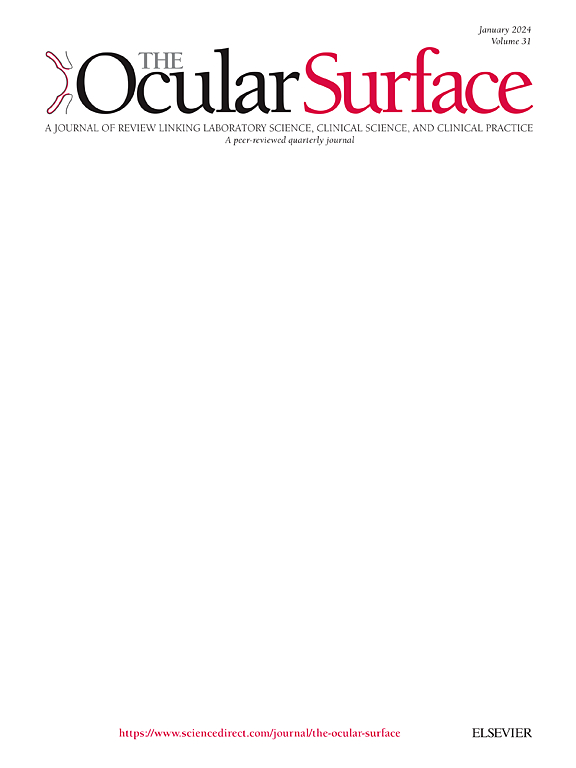研究泪液稳态体征对干眼病诊断的相对重要性。
IF 5.6
1区 医学
Q1 OPHTHALMOLOGY
引用次数: 0
摘要
目的:不采用标准化诊断标准,极易误诊。当评估泪膜稳态的测试被纳入/排除在多项测试方案中时,本研究系统地检查了对干眼病(DED)诊断的影响。方法:对来自5个地点的1427名参与者的泪膜和眼表学会干眼研讨会II (TFOS DEWS II)诊断方法学报告算法中定义的全套诊断测试数据进行评估;当单个体征被移除时,以及当需要不同的体征组合时,计算诊断敏感性。结果:仅评估三种TFOS DEWS II稳态体征中的一种,导致12.3%至36.2%符合DED诊断标准的患者未被分配此诊断。综合眼表染色评估,包括角膜、结膜和眼睑边缘染色,结合症状对三种标记物的敏感性最高(87.7%),而仅评估角膜染色的敏感性降至44.6%。结论:TFOS DEWS II症状诊断算法加上泪膜或眼表征象的评估可以被认为是诊断DED的一种可靠和适当的方法。本文章由计算机程序翻译,如有差异,请以英文原文为准。
Relative importance of tear homeostatic signs for the diagnosis of dry eye disease
Aim
Disease misdiagnosis is more likely if standardised diagnostic criteria are not used. This study systematically examined the effect on diagnosing dry eye disease (DED), when tests for evaluating tear film homeostasis were included or excluded from a multi-test protocol.
Method
For 1,427 participants across five sites, data for the full suite of diagnostic tests defined in the Tear Film and Ocular Surface Society Dry Eye Workshop II (TFOS DEWS II) Diagnostic Methodology report algorithm were evaluated; diagnostic sensitivity was calculated when individual signs were removed, and when different combinations of signs were required.
Results
Evaluating just one of the three TFOS DEWS II homeostatic signs resulted in between 12.3 % and 36.2 % of patients who met the DED diagnostic criteria not being assigned this diagnosis. While comprehensive ocular surface staining evaluation, comprising of corneal, conjunctival and lid margin staining, in combination with symptoms had the highest sensitivity (87.7 %) of the three markers, the sensitivity dropped to 44.6 % if only corneal staining was evaluated. Omitting either non-invasive tear breakup time or tear osmolarity each dropped the sensitivity by <5 %. The prevalence of DED was substantially reduced if a diagnosis required symptoms and two of the three signs to be present (by 43.7 %–61.2 %) and by 65.9 % if all three signs indicating a loss of tear film homeostasis were required. The outcomes of the analysis did not change significantly across differing severities of DED symptoms.
Conclusions
The TFOS DEWS II diagnostic algorithm of symptoms plus assessing for a tear film (non-invasive tear breakup time or tear osmolarity) and ocular surface sign can be considered a robust and appropriate approach for DED diagnosis.
求助全文
通过发布文献求助,成功后即可免费获取论文全文。
去求助
来源期刊

Ocular Surface
医学-眼科学
CiteScore
11.60
自引率
14.10%
发文量
97
审稿时长
39 days
期刊介绍:
The Ocular Surface, a quarterly, a peer-reviewed journal, is an authoritative resource that integrates and interprets major findings in diverse fields related to the ocular surface, including ophthalmology, optometry, genetics, molecular biology, pharmacology, immunology, infectious disease, and epidemiology. Its critical review articles cover the most current knowledge on medical and surgical management of ocular surface pathology, new understandings of ocular surface physiology, the meaning of recent discoveries on how the ocular surface responds to injury and disease, and updates on drug and device development. The journal also publishes select original research reports and articles describing cutting-edge techniques and technology in the field.
Benefits to authors
We also provide many author benefits, such as free PDFs, a liberal copyright policy, special discounts on Elsevier publications and much more. Please click here for more information on our author services.
Please see our Guide for Authors for information on article submission. If you require any further information or help, please visit our Support Center
 求助内容:
求助内容: 应助结果提醒方式:
应助结果提醒方式:


